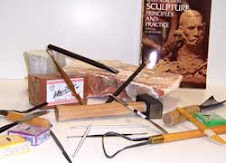
Making Polymer Clay Beads: Step-by-Step Techniques for Creating Beautiful Ornamental Beads
By Carol Blackburn
Customer Reviews
Detailed steps, clear guidelines/recommendations provide confidence in making your own beautiful polymer beads!
First off - yes, there are LOTS of books available showing all sorts of different projects using polymer clay and no, you won't become an expert overnight with this one or any other one. HOWEVER, Blackburn has provided a book with updated information and the guidelines to get you on your way to make the beads of your dreams - referring to the first section entitled "Materials and Techniques:" espcially, blending-Skinner Tech., Combing, Caning, Molding, Shapes, Drilling, Polishing (very important), Varnishing, Foils, Extrusions, Textures, Transfers Stamping, Mokume Gane, Mica Shift and more. Just remember, she and others making beautiful polymer products do this all the time and so practice, practice, practice. That being said, I have to say that I truly enjoy this book as so many others have mentioned - that being the focus on bead making. My own efforts over many months of work were so so at best. Once I followed her steps, which are given with photos & written info for each step, I am much more pleased with my own beads.
My main interest in this book has been section two "Faux Techniques" - wood, marble, ivory/bone, leather, amber, coral bronze, abalone, jade, mother-of-pearl (amazing), silver, malachite, turquoise, lapis, onyx, agate. For the most part, I have been extremely pleased at the outcomes of my efforts, but some of Blackburn's representations of imitating certain things could be better. Lapis - get the book "Polymer-The Chameleon Clay" by V. Hughes in order to get a more realistic lapis stone appeal, same as for jade - but this 2nd book is horrible when it comes to Turquoise (also described in Blackburn's book but still not as realistic as I would like...a difficult stone to mimic). So I use the Hughes book for some faux items. Blackburn does have some outstanding examples (IMHO) of Wood (not the ultimate best, but close); Veined Marble - compared to the real thing, I was amazed; Coral bead work was admirable and worth practicing to get it just right; Abalone - love it - very realistic; Jade was comparable to Hughes work; Mother-of-Pearl - truly striking, especially when making the colored pearls; Malachite - close but before YOU make it examine natural malachite in order to develop a more realistic color pattern but still closely following Blackburn in the color production end; Onyx - MY FAVORITE - actually it is more like a natural agate stone as typically when you think of onyx, it is black. Blackburn's Onyx is highly layered using products that I wish I would have thought of...but now I know...in order to get a REALLY natural looking agate stone bead. Blackburn's section on "Agate" in the "Faux Techniques" applies more to a cut stone of agate and she has produced some interesting pendant type pieces. But again, get an Agate book and try to mimic some of the patterns of real agates following Blackburn's technique. You won't be sorry.
Sections to use other books or to keep trying to find better ways to mimic these items are: silver, turquoise, lapis, bronze (this could go either way for some of Blackburn's pieces are admirable - same with her amber pieces), ugh on the leather look, and noooo on the ivory and bone beads. Books with more realistic bone are "The Polymer Clay Techniques Book" by S. Heaser - and pay attention to the antiquing section for bone or "Faux Surfaces in Polymer Clay" by I.S. Dean where the best looking bone look is shown. However, both these books lack the more detailed descriptions and images that Blackburn provides in her book. Yet, Blackburn's work/descriptions are a great way to start from in getting the look you may want using products she recommends.
Excelente!
Adorei, muito didático, conteúdo bem explicado, com ótimas sugestões e idéias, bom gosto. Altamente recomendado.
In the 3rd section of the book called "Bringing It All Together" - she does a great job of pulling the necessary items needed to really make the beads - from various jewelry findings, cording, attaching, designing...thus flowing smoothly into the final section "The Gallery." Many of the great polymer bead artists' work is shown here and definitely grab your attention. Yet this section is small as Blackburn focuses upon the other areas mentioned above and thus earning more stars from me as that is the reason I wanted the book...not for the gallery but for the great guidelines and examples to help ME develop my own pieces.
With all this being said...or rather written...by me, I guess I have to say there is not just one book for all things in polymer clay. However, I feel the layout, descriptions, images and all around clarity by Blackburn makes her book stand out in my library. I am glad to have the NUMEROUS other books, magazines, etc. on polymer clay plus seeing some of the extraordinary work by many artists focused on this medium - all of which increases my drive to improve my own work with polymer clay...and hopefully your own work as well. This medium is amazing and so available - use Blackburn's book as a great stepping stone and you definitely will not be disappointed.
10 stars
If I could give one polymer clay book 10 stars this book would be IT.
The best book I have ever read about polymer clay.
Super projects and tips and everything is so well written and pictured.
Product Details
- Amazon Sales Rank: #29818 in Books
- Published on: 2007-04-01
- Original language: English
- Number of items: 1
- Binding: Paperback
- 128 pages



